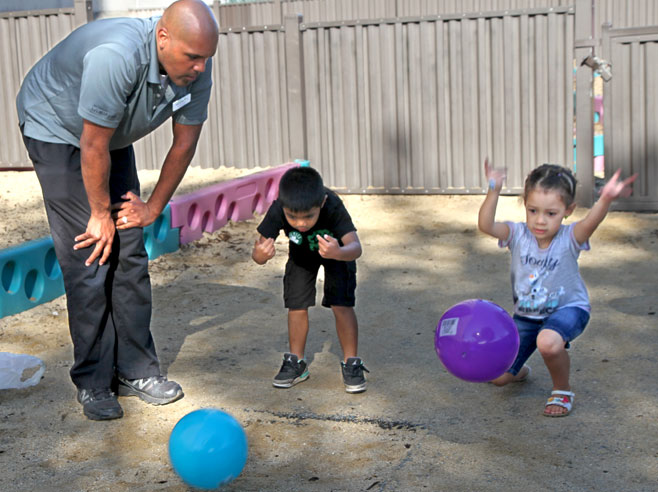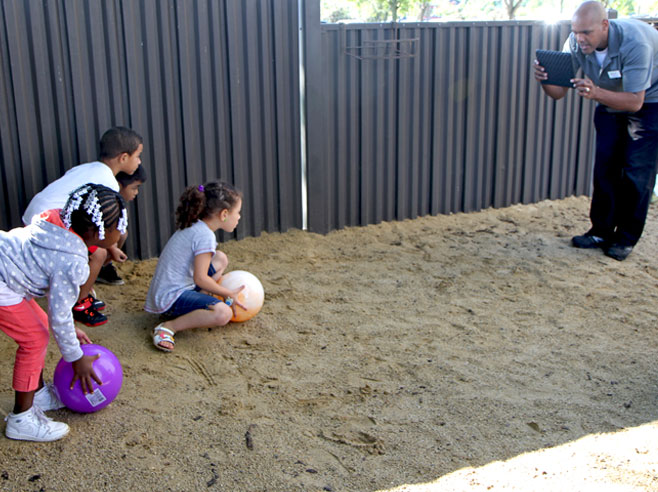Children roll balls and other objects down a variety of outdoor surfaces (grass, dirt, pavement). They observe how far the objects roll on surfaces and what causes the objects to stop.
Materials

- Balls and other rolling objects of various sizes and weights, such as tubes, cans, spools, etc.
- Clipboard
- iPad for taking videos of children rolling objects on different surfaces
- Paper
- Pen
Preparation
- Gather some rolling objects of various sizes and weights: balls, cans, tubes, rolls of duct tape, large toy cars, etc. If possible, include a few pairs of identical balls.
- Locate an outdoor area with a variety of inclined surfaces (dirt, grass, sidewalk, blacktop, sand) where children can safely roll balls and other objects. Experiment with the objects and different surfaces. For example, if you place a ball on a paved surface that appears flat, you may discover that the surface is actually an incline when the ball starts to roll.
- Look for places where you can roll identical balls side by side on two different surfaces—for example, a paved surface next to dirt or grass.
- You will be taking videos and photos of the children. Use the standard video and camera features on the iPad.
- Note: You may want to focus on a subset or combination of learning goals, depending on the kinds of ramps available outdoors in your area.
Directions: Lesson 9
Outdoors
- Take children to the outside space you have selected. Review any safety rules. Discuss surfaces and ramps in the space. Possible discussion ideas:
- What different surfaces do you see? Can you describe the texture of each surface?
- Which surfaces are ramps? Which ramps are steep? Gentle?
- Which surfaces do you think are the steepest? The flattest?
- Which surfaces do you think are smooth? Rough? The smoothest? The roughest?
- What makes objects slow down or stop?
- Have children predict on which surface the objects will roll farthest. Write down children’s predictions on the paper. Ask, Why do you predict that?
- Use the iPad to take a video of children rolling objects down this surface. If their predictions prove incorrect, take a video of children rolling objects down the surface where objects really did roll farthest.
- Have children predict on which surface the objects will not roll very far. Why do you think that? Jot down children’s predictions.
- Take a video of children rolling objects down this surface. If their predictions prove incorrect, take a video of children rolling objects down the surface where the object did not roll very far.
- Have children roll balls and other objects on the different surfaces. Document their activities by taking videos and photos. Talk with children about what they observe and write down their observations. If needed, use discussion ideas to start the conversation, such as:
- On which surfaces do the objects roll farthest? Least far? Were our predictions correct?
- What makes the objects travel different distances?
- See if there are places where you can roll two objects side by side—one on a paved surface and the other on dirt or grass right next to it. Encourage children to set up an “experiment” to compare how far two identical balls roll over the two different surfaces. Take a video of this experiment.
Note: The class will view and discuss the videos and photos you have taken during the Hills and Surfaces Revisited Circle Time: Wrap-Up activity.


